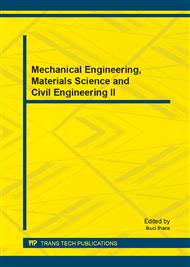p.100
p.104
p.108
p.112
p.116
p.124
p.128
p.132
p.137
Construction of the Macro-Mesoscopic Yield Criterion of Concrete Based on the Technique of Energy Density Supporting Function
Abstract:
The concrete can be taken as a composite material consisting of mortar matrix, aggregates and the bond between them in mesoscopic. And the shape of aggregate is assumed to be sphere and the mortar matrix is supposed to satisfy the D-P yield criteria. The energy density support function is introduced to reflect the yield surface of mortar matrix. In order to solve the non derivability on the yield boundary, the function approaching series is constructed to substitute for the energy density function. Finally, a macro-mesoscopic yield criterion of concrete material is derived by nonlinear homogenized technique. Through this macro-mesoscopic yield criterion, the influence regularity of the bonding status of interface and the fraction of aggregate on the macro friction coefficient is explored. //
Info:
Periodical:
Pages:
116-123
Citation:
Online since:
December 2013
Authors:
Price:
Сopyright:
© 2014 Trans Tech Publications Ltd. All Rights Reserved
Share:
Citation:


